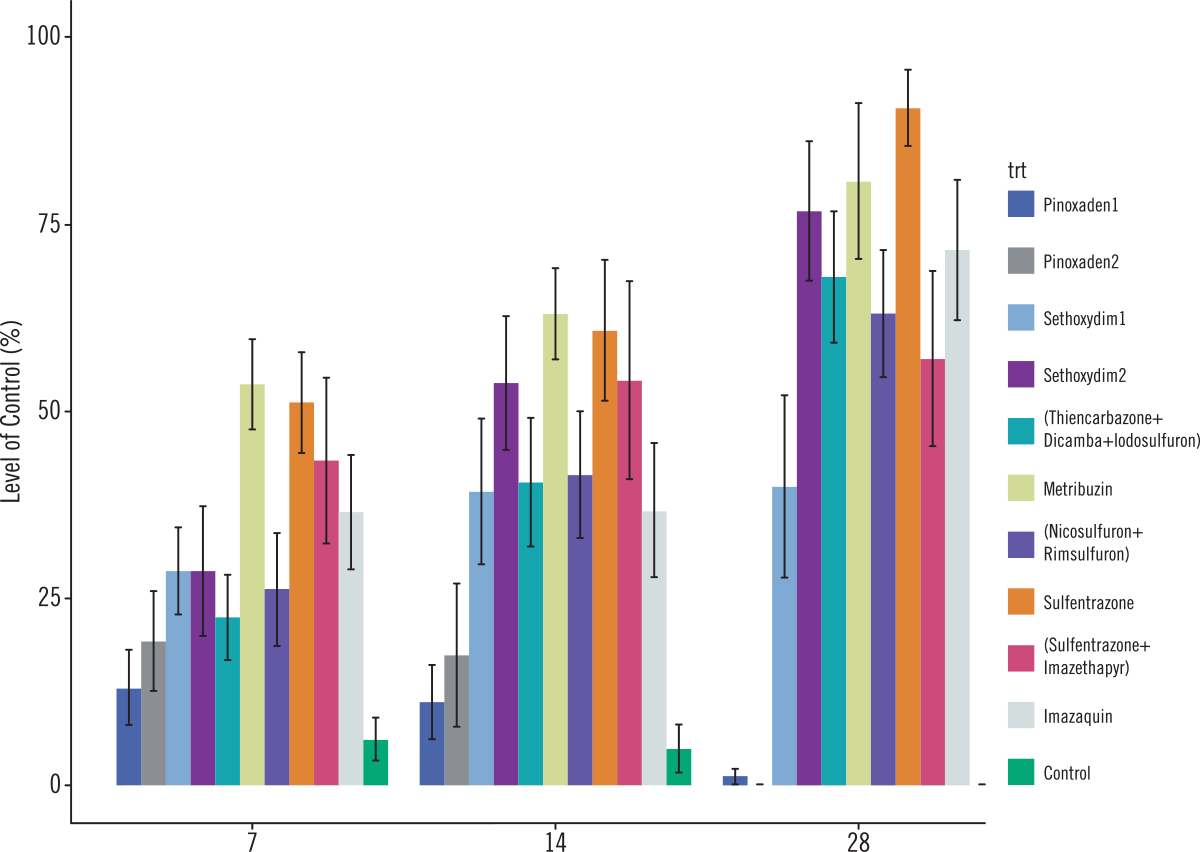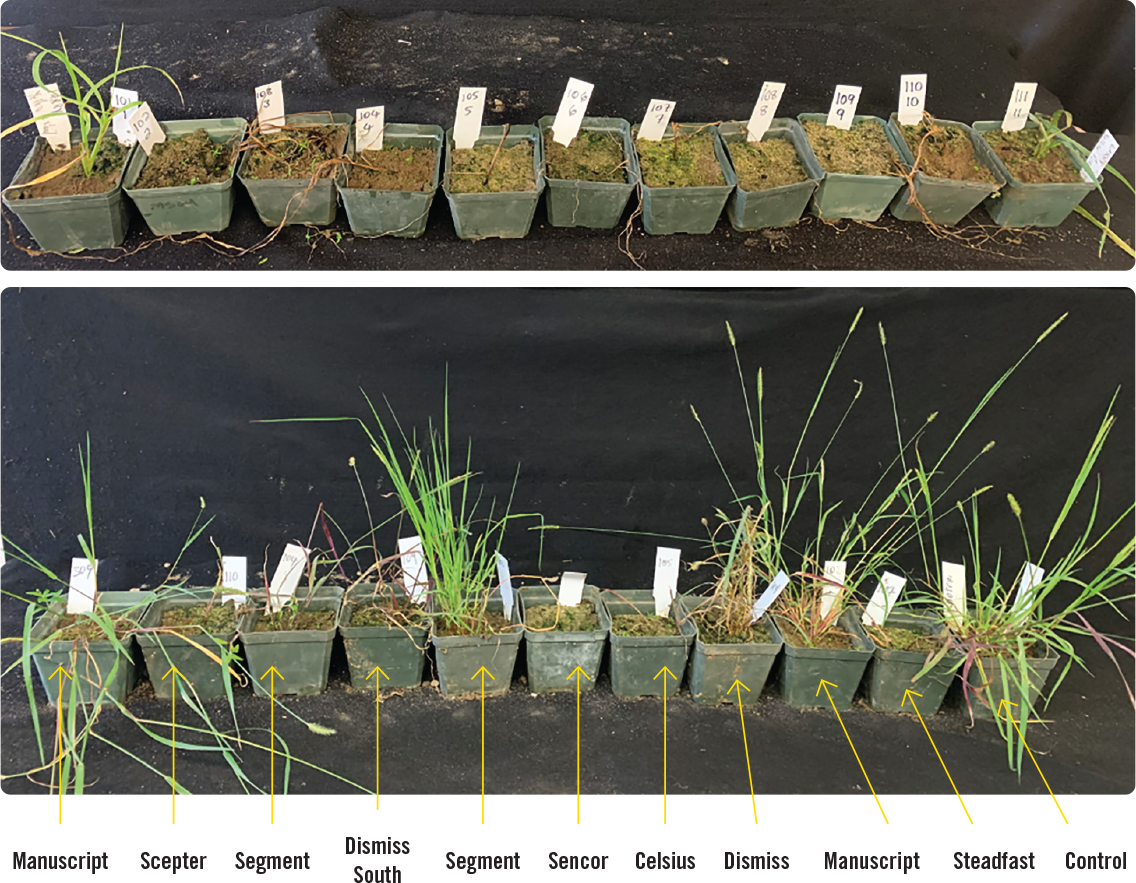
7 minute read
Cover Story
Control of Yellow and Knotroot Foxtail in Southern Turfgrass
By Mikerly Joseph, Dave Han, and Scott McElroy, Auburn University | Current address of first author: University of Florida
In the southeastern region of the United States, Setaria pumila and Setaria parviflora, respectively known as yellow and knotroot foxtail, are two common species infesting managed and unmanaged turfgrass, pastures, roadsides, and some cropping systems (Bryson and DeFelice, 2009; Hitchcock, 1971). Yellow and knotroot foxtail originated from Asia and North America, respectively (Dekker, 2003; Rominger, 1962a). Nevertheless, they are very similar in appearance and are frequently mistaken for each other, leading to confusion in herbicide selection (Darmency and Dekker, 2011).
The primary differences between yellow and knotroot foxtail are found in the seedhead with yellow foxtail seedheads bigger and denser with more hairs (Darmency and Dekker, 2011). Other studies found that knotroot foxtail can be differentiated from yellow by the presence of rhizomes (Wang et al., 1995). However, since these characteristics appear late during development or sometimes are not apparent at all, it is very difficult to tell the two species apart in the field (Wang et al., 1995).
Yellow and knotroot foxtail are annual and perennial weeds, respectively, with few options for effective chemical control in warm-season turfgrass. Pinoxaden is labeled in the United States for use on bermudagrass controls of yellow foxtail post emergence (Peppers et al., 2020), but pinoxaden is not labeled to control knotroot foxtail (Peppers et al., 2020). Chlorsulfuron gave season-long control of yellow foxtail when applied at the early growth stage in Kentucky bluegrass, but it is not labeled in turfgrass (Maloy, 1985). Imazethapyr controls yellow foxtail effectively as a preemergence with no detrimental effects on grass establishment (Fry et al., 1997).
Little research has been done to gain an understanding of the chemical control of knotroot foxtail. In pastures, hexazinone alone or applied with metsulfuron + dicamba + 2,4-D, controlled knotroot foxtail by more than 70% two weeks after application, as did chlorsulfuron or nicosulfuron (Coats et al., 1999). Nicosulfuron + metsulfuron controls knotroot foxtail 70% in bermudagrass forage at the actively growing stage (Rusell, 2021).
Other herbicides could potentially control yellow and knotroot foxtail but are not currently labeled. For instance, thiencarbazone + dicamba + iodosulfuron is labeled for controlling yellow foxtail and giant foxtail but not knotroot foxtail.
The objectives of this research were to (1) evaluate the response of yellow foxtail and knotroot foxtail to several turfgrass herbicides and (2) evaluate the rate response of yellow and knotroot foxtail to increasing rates of pinoxaden and sethoxydim and estimate the application rate at which 50% (I50) of both species was injured.
Material and Methods
Research was conducted in 2021 and 2022 in greenhouse populations to evaluate yellow and knotroot foxtail response to different turfgrass herbicides. Two experiments were conducted at the Auburn University Weed Science greenhouse in Auburn, AL in 32/28 C (+/-1 C Day/night) conditions with an average relative humidity of 70%. Seeds of both species were harvested from a local population in Montgomery, Alabama. Seeds were cleaned and stored at 4oC prior to the experiments. Seeds were planted in flats of potting medium and were then transplanted individually at three leaves stage into 230 cm3 pots, filled with sandy soil. Treatments were applied two weeks after transplantation. After treatment, pots were not watered for approximately 24 hours to allow for adequate leaf absorption. See Figure 1 for the herbicide treatments.
The treatments were evaluated for percent weed control at 7, 21 and 28 days after application (DAA) and above ground biomass of the foxtail plants were evaluated at 28 DAA.

Results and Discussion
In greenhouse evaluation, yellow and knotroot foxtail responded differently to the selected herbicides. All the herbicides were effective on yellow foxtail with more than 85 % at 28 days after application (DAA) (Figure 2). Aboveground biomass data followed the same pattern. All the herbicides reduced yellow foxtail above-ground biomass by more than 95% compared to the nontreated at 28 DAA.

Knotroot foxtail was more difficult to control in general than yellow foxtail. Sulfentrazone controlled knotroot foxtail > 90 %, which was the best treatment statistically. Similarly, metribuzin controlled knotroot foxtail 81%, imazaquin 71%, sethoxydim (high rate) 76%, and thiencarbazone + dicamba + iodosulfuron 68% control (Figure 2). All the other treatments controlled knotroot foxtail by less than 65%. Relative plant fresh-weight data agreed with visually estimated control data. Sulfentrazone, metribuzin, sethoxydim (high rate), thi encarbazone+dicamba+iodosulfuron and imazaquin reduced the above ground biomass by more than 90% and nicosulfuron+rimsulfuron reduced knotroot foxtail biomass by 89%. However, pinoxaden (low and high rates) were less effective on knotroot foxtail with less than 30% biomass reduction.

Bottom Line
This study found that yellow foxtail responded differently to herbicides than knotroot foxtail, and knotroot foxtail was more difficult to control. Based on the greenhouse studies, sulfentrazone, sethoxydim (high rate) thiencarbazone + dicamba + iodosulfuron, and metribuzin can be considered for controlling yellow and knotroot foxtail at label rates. Knotroot foxtail response was more variable and pinoxaden should not be considered for controlling knotroot foxtail even at the maximum recommended label rate. Sethoxydim provided effective control of yellow foxtail and reduced knotroot foxtail biomass by more than 60% at the labeled rate. Responses observed in this study suggest that differentiation between yellow and knotroot foxtail is essential for predictable results with herbicides. •

Literature Cited
Bryson CT, DeFelice MS (2009) Weeds of the south Athens, GA: University of Georgia Press. Pp. 495
Coats GE, Taylor JM, Kelly ST, Helms RB, Scott TD (1999) Highway vegetation management Mississippi: Miss. Agric. and Forest. 122 p
H, Dekker J (2011) Setaria. Pages 275-291 in Kole C, ed. Wild Crop Relatives : Genomic and Breeding Resources. Clemson: Springer
Dekker J (2003) The foxtail (Setaria) species-group. Weed Science 51:641-656
Dyer LM, Henry GM, McCullough PE, Belcher J, Basinger NT (2022) Knotroot Foxtail [Setaria parviflora (Poir.) Kerguélen]:“A sly fox”. Weed Technology:1-22
Fry JD, Gaussoin RE, Beran DD, Masters RA (1997) Buffalograss Establishment with Preemergence Herbicides. Hortscience 34 Hitchcock AS (1971) Manual of the grasses of the United States. New york: Dover
Kotu V, Deshpande B (2018) Data science: concepts and practice: Morgan Kaufmann
Maloy BM (1985) Selective control of perennial grasses in Kentucky 21 blue-grass (Poa pratensis L.) turf with chlorsulfuron. Master of science Iowa Iowa State University
Ogle DH, Doll JC, Wheeler P, Dinno A (2022) FSA: Fisheries Stock Analysis
Peppers JM, Gonçalves CG, McElroy JS (2020) Rate response of select grass weeds to pinoxaden. Weed Technology 34:818-823
Ritz C, Baty F, Streibig J, Streibig C, Gerhar D (2015) DoseResponse Analysis Using R. PLOS ONE 10
Rominger JM (1962) Taxonomy of Setaria (Gramineae) in North America in Press TUoI, ed. Urbana
Rusell D (2021) Widespread Foxtail Distribution Leads to Tough Management Decisions. Forages
Wang RL, Wendel JF, Dekker JH (1995) Weedy adaptation in Setaria spp II Genetic diversity and population genetic. American Journal of Botany 82:1031-1039





